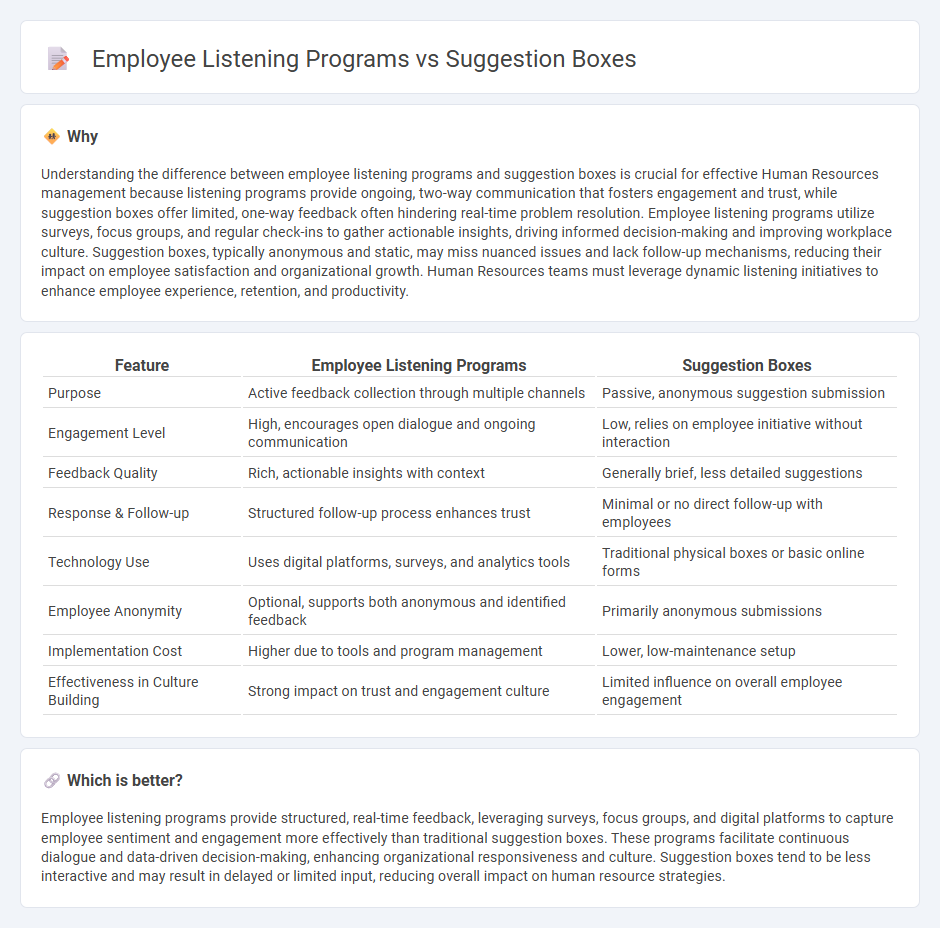
Employee listening programs leverage real-time feedback tools like surveys and focus groups to capture dynamic workforce insights, enhancing engagement and decision-making. Suggestion boxes offer a traditional, anonymous channel for employees to submit ideas but often lack immediacy and interaction. Explore the impact of these approaches on workplace culture and productivity.
Why it is important
Understanding the difference between employee listening programs and suggestion boxes is crucial for effective Human Resources management because listening programs provide ongoing, two-way communication that fosters engagement and trust, while suggestion boxes offer limited, one-way feedback often hindering real-time problem resolution. Employee listening programs utilize surveys, focus groups, and regular check-ins to gather actionable insights, driving informed decision-making and improving workplace culture. Suggestion boxes, typically anonymous and static, may miss nuanced issues and lack follow-up mechanisms, reducing their impact on employee satisfaction and organizational growth. Human Resources teams must leverage dynamic listening initiatives to enhance employee experience, retention, and productivity.
Comparison Table
| Feature | Employee Listening Programs | Suggestion Boxes |
|---|---|---|
| Purpose | Active feedback collection through multiple channels | Passive, anonymous suggestion submission |
| Engagement Level | High, encourages open dialogue and ongoing communication | Low, relies on employee initiative without interaction |
| Feedback Quality | Rich, actionable insights with context | Generally brief, less detailed suggestions |
| Response & Follow-up | Structured follow-up process enhances trust | Minimal or no direct follow-up with employees |
| Technology Use | Uses digital platforms, surveys, and analytics tools | Traditional physical boxes or basic online forms |
| Employee Anonymity | Optional, supports both anonymous and identified feedback | Primarily anonymous submissions |
| Implementation Cost | Higher due to tools and program management | Lower, low-maintenance setup |
| Effectiveness in Culture Building | Strong impact on trust and engagement culture | Limited influence on overall employee engagement |
Which is better?
Employee listening programs provide structured, real-time feedback, leveraging surveys, focus groups, and digital platforms to capture employee sentiment and engagement more effectively than traditional suggestion boxes. These programs facilitate continuous dialogue and data-driven decision-making, enhancing organizational responsiveness and culture. Suggestion boxes tend to be less interactive and may result in delayed or limited input, reducing overall impact on human resource strategies.
Connection
Employee listening programs enhance organizational communication by systematically gathering feedback, while suggestion boxes serve as a tangible tool within these programs to capture anonymous ideas and concerns. Integrating suggestion boxes into employee listening initiatives fosters a continuous dialogue, promoting employee engagement and trust. Data collected from suggestion boxes informs HR strategies, driving improvements in workplace culture and productivity.
Key Terms
Feedback Mechanisms
Suggestion boxes offer a traditional, anonymous channel for employees to submit feedback at their convenience, often leading to sporadic and unstructured insights. Employee listening programs utilize continuous, multi-channel approaches including surveys, one-on-one meetings, and pulse checks, enabling real-time data collection and more dynamic engagement. Explore how integrating advanced feedback mechanisms can enhance organizational communication and drive meaningful change.
Engagement
Suggestion boxes provide a simple method for employees to contribute ideas, but they often lack the interactive feedback loop critical for sustained engagement. Employee listening programs incorporate surveys, focus groups, and real-time feedback tools that enable continuous dialogue and foster a culture of openness and trust. Explore how structured listening initiatives can significantly enhance employee involvement and organizational performance.
Anonymity
Suggestion boxes offer basic anonymity but often lack thorough follow-up mechanisms, which can lead to employee skepticism about the confidentiality of their input. Employee listening programs use advanced technologies like encrypted feedback channels and anonymous surveys to ensure employees feel safe sharing honest opinions without fear of identification. Discover how integrating robust anonymity features in listening programs can enhance trust and drive meaningful organizational change.
Source and External Links
Ideas for Using a Suggestion Box in the Workplace - This article provides strategies for effectively using suggestion boxes to encourage employee feedback and foster open communication in the workplace.
Suggestion Boxes - Grainger Industrial Supply - Grainger offers a variety of suggestion boxes designed to maintain confidentiality while collecting feedback, suitable for both customer and employee use.
Wood Suggestion Box for Countertops & Wall Mounting - This wooden suggestion box provides a decorative way to collect feedback, featuring locking designs and various finishes for a classy look.
 dowidth.com
dowidth.com